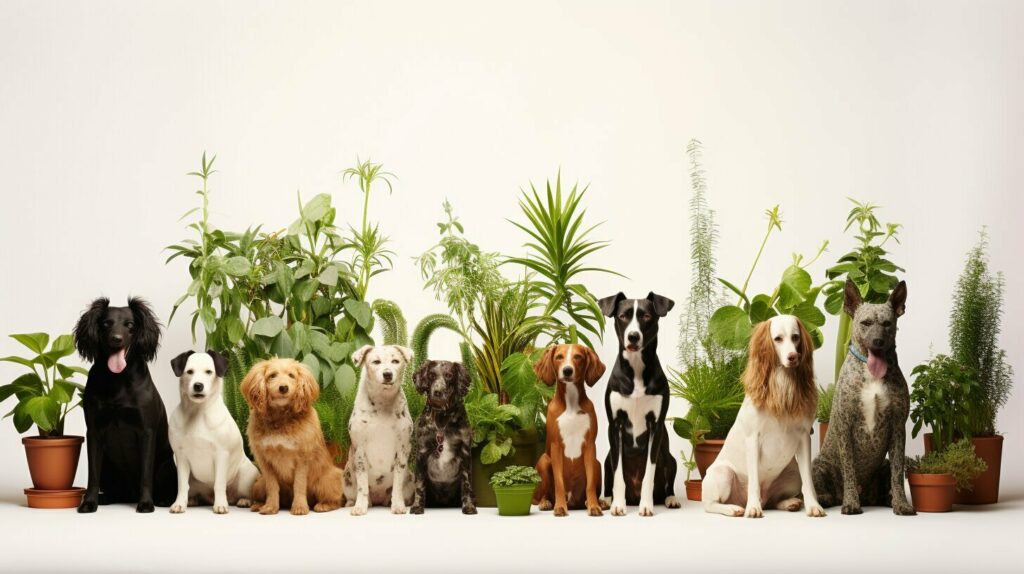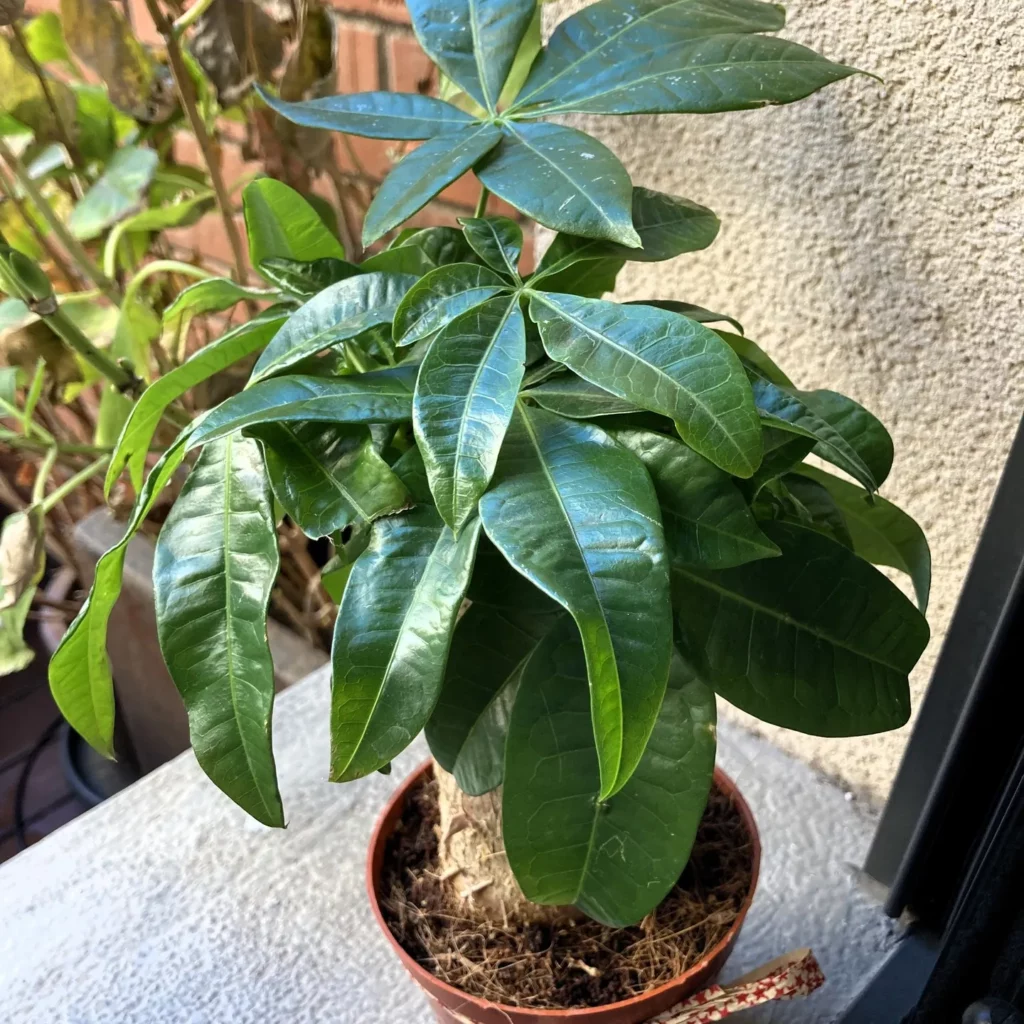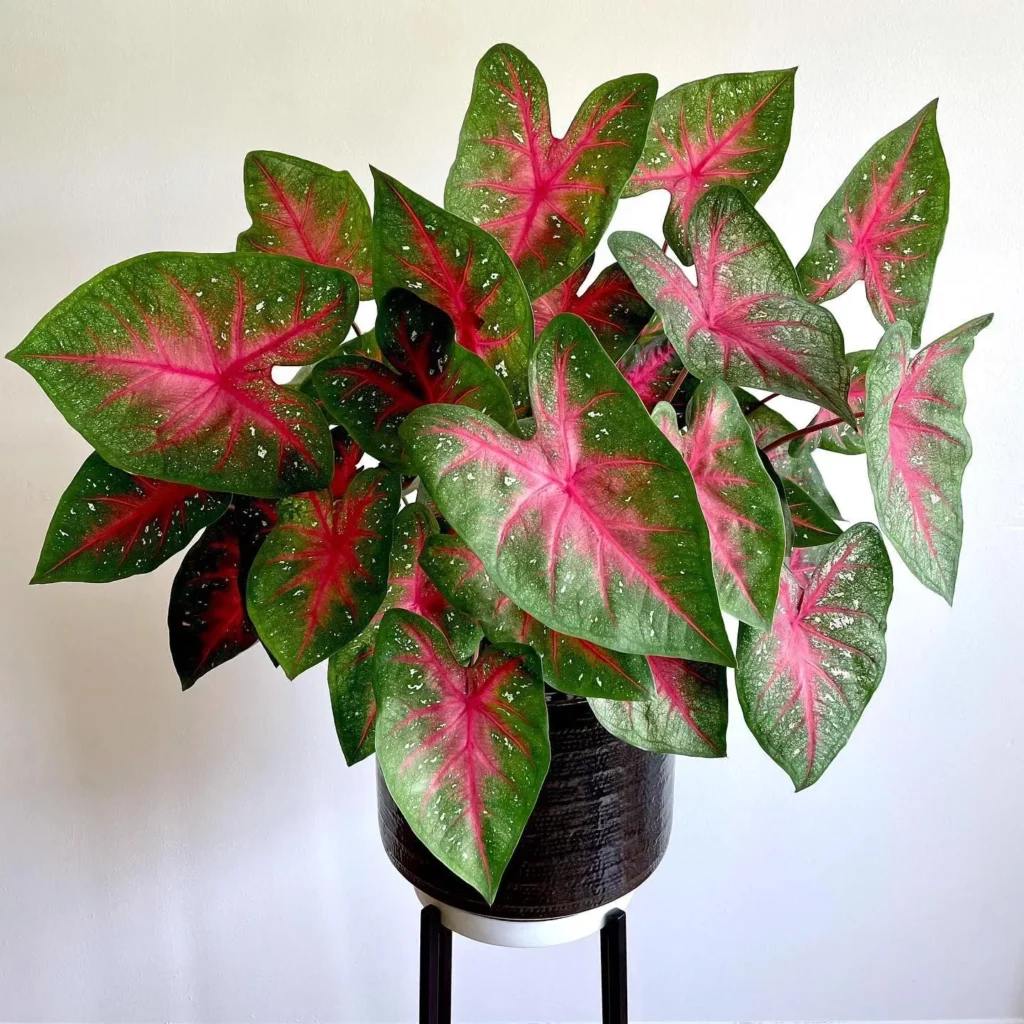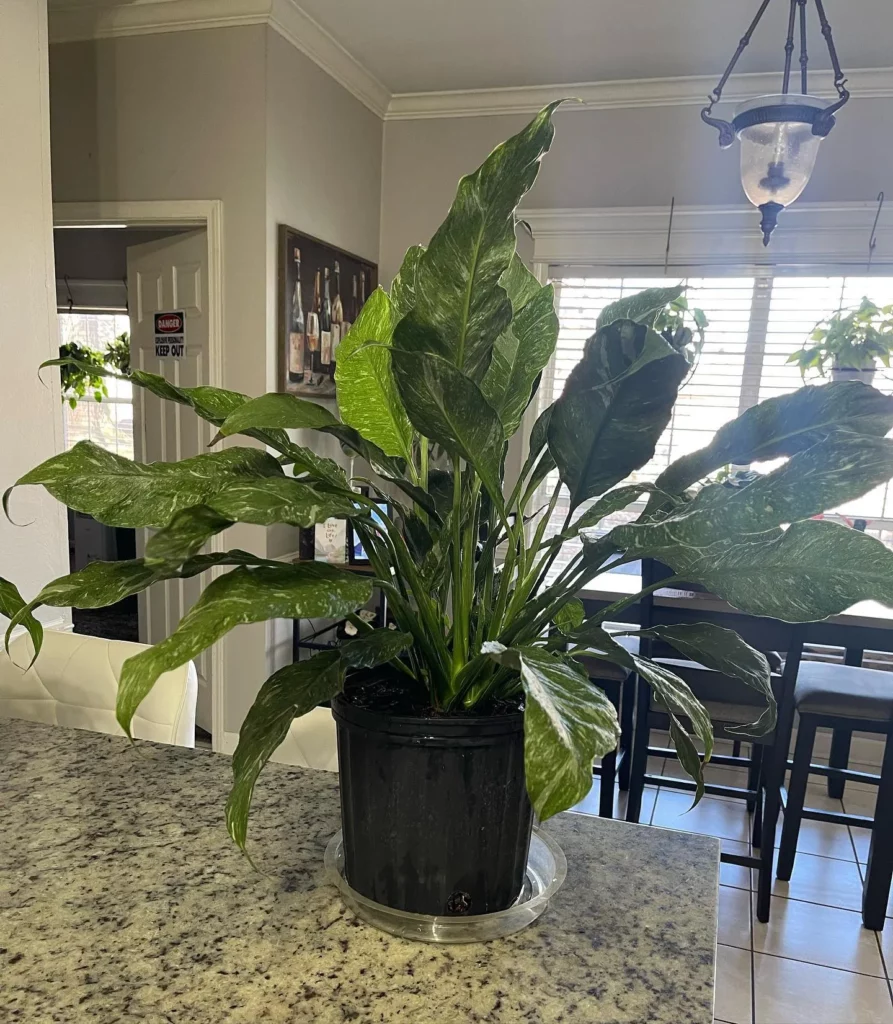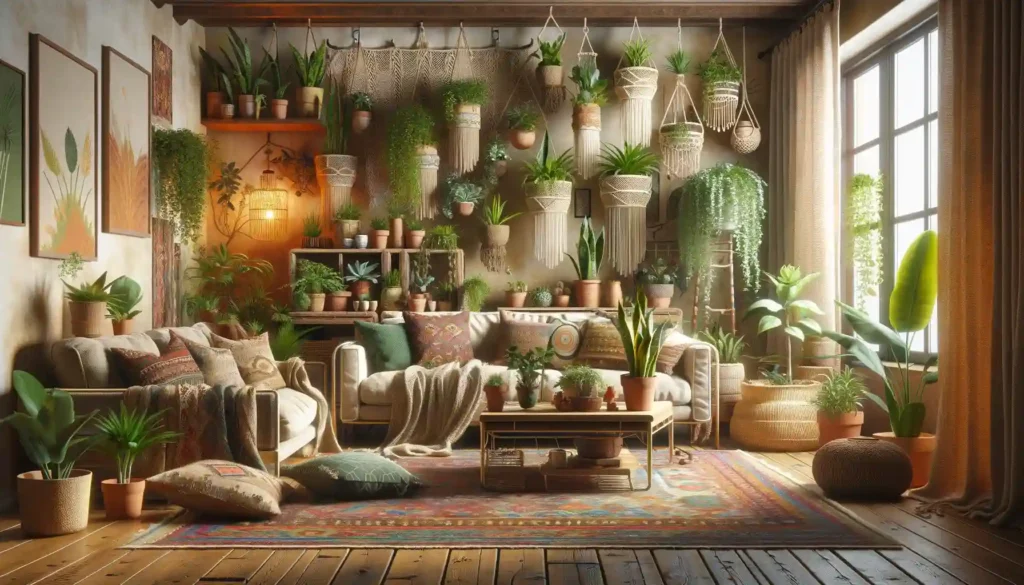Looking to add a touch of nature to your home but worried about the safety of your furry friend? Look no further! In this article, I will introduce you to 11 dog-friendly houseplants that are not only safe for dogs but also make beautiful additions to your space.
It’s crucial to choose pet-friendly houseplants to avoid any potential harm to your beloved pup. Many common houseplants can be toxic to dogs, causing mild to severe symptoms.
The Importance of Dog-Friendly Indoor Plants
When it comes to creating a safe and dog-friendly environment in your home, choosing the right indoor plants is crucial. Many common houseplants can be toxic to dogs if ingested, leading to a range of symptoms from mild gastrointestinal upset to more severe health issues. By selecting dog-friendly plants, you can ensure the well-being of your furry companion and create a beautiful and inviting space for both you and your pet.
Plant toxicity in pets can vary depending on the type and amount of plant consumed. Some plants, such as lilies, azaleas, and sago palms, can be highly toxic and even life-threatening to dogs. Ingesting these plants can cause symptoms like vomiting, diarrhea, drooling, difficulty breathing, seizures, and even organ failure. It’s essential to be aware of the potential dangers and take proactive measures to prevent your dog from accessing toxic plants.
By incorporating dog-friendly indoor plants into your home, you not only provide a safe environment for your four-legged friend but also reap the benefits of greenery. Indoor plants have been shown to improve air quality, reduce stress levels, and enhance overall well-being. They can help create a calming and soothing atmosphere for both you and your pet, promoting a healthy and harmonious living space.
- Choose indoor plants that are non-toxic and safe for dogs.
- Be aware of common toxic houseplants to avoid.
- Consult reputable resources like the Pet Poison Helpline or ASPCA for guidance on pet-safe plants.
- Consider the specific needs of your dog, such as allergies or chewing tendencies, when selecting plants.
- Place plants out of reach or use barriers to prevent dogs from accessing them.
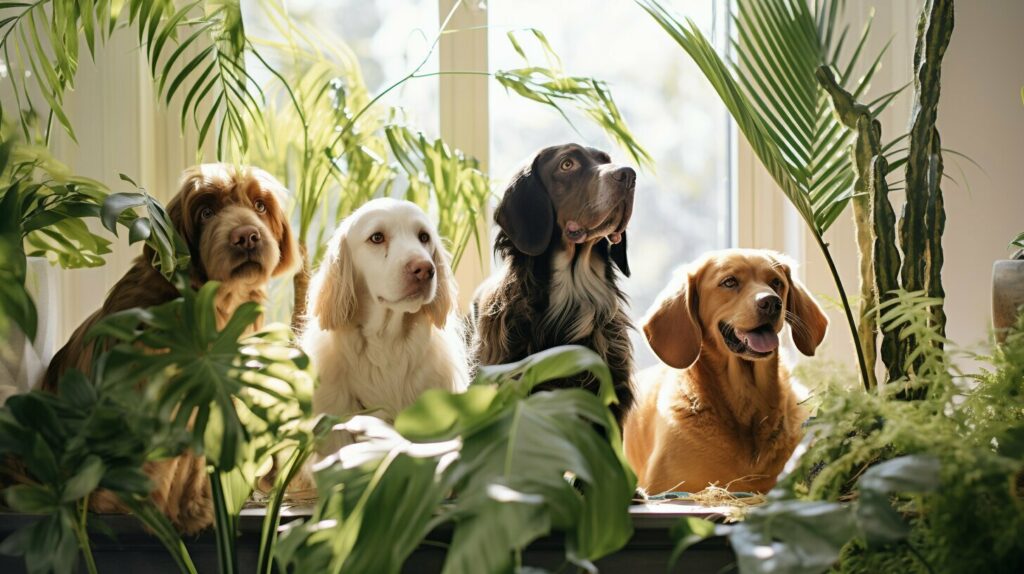
Protecting Your Dog: Tips for a Pet-Friendly Home
While it’s essential to be aware of the common houseplants toxic to dogs, there are steps you can take to create a pet-friendly home environment:
- Research Before You Buy: Before bringing a new houseplant into your home, make sure to research its toxicity level for dogs. Consult resources like the ASPCA’s list of toxic and non-toxic plants to ensure you make safe choices.
- Elevate Your Plants: Keep toxic plants out of your dog’s reach by placing them on high shelves, using hanging planters, or creating barriers to prevent access.
- Consider Pet-Safe Alternatives: If you still want to enjoy greenery in your home, there are plenty of pet-friendly houseplants available. Opt for non-toxic options like spider plants, Boston ferns, or African violets.
- Monitor Your Dog’s Behavior: Keep an eye on your dog’s interactions with houseplants. If you notice any chewing or nibbling, redirect their attention to appropriate chew toys or provide them with designated safe plants to interact with.
- Train Your Dog: Teach your dog basic obedience commands like “leave it” or “stay” to discourage them from approaching or ingesting plants. Positive reinforcement training methods can be effective in creating boundaries.
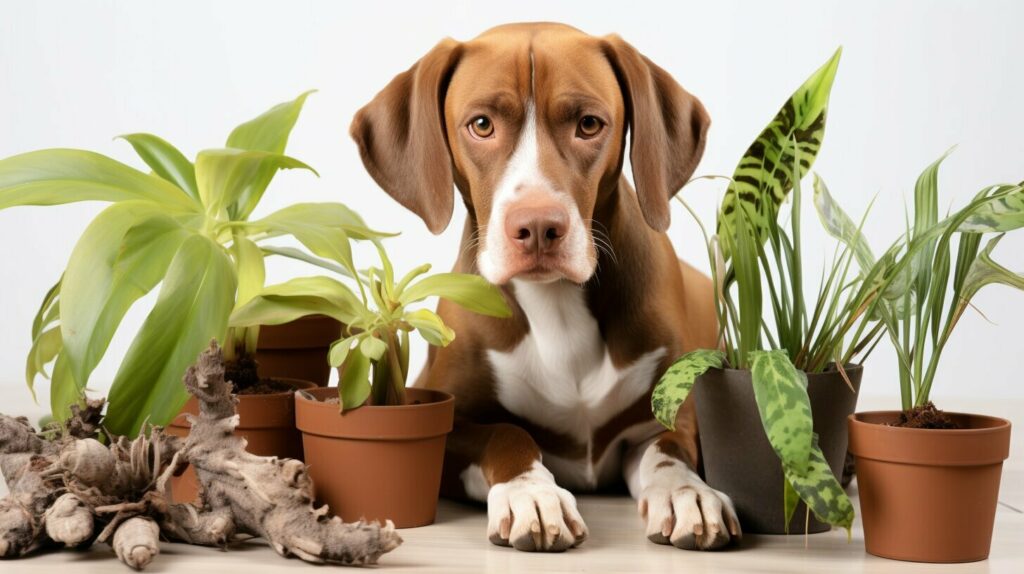
By following these tips and being mindful of the houseplants you bring into your home, you can create a safe and dog-friendly environment where both you and your furry friend can enjoy the benefits of greenery.
Finding Safe Houseplants for Dogs
To find pet-safe plants, here are some tips:
- Consult with garden center staff: When shopping for houseplants, don’t hesitate to ask for assistance from knowledgeable garden center staff. They can provide you with valuable information about the pet-friendliness of various plants and guide you towards safe options for your dog.
- Check reputable resources: The Pet Poison Helpline and the ASPCA offer lists of pet-safe plants that you can use as a reference. Cross-referencing information from multiple reliable sources is essential in ensuring that the plants you choose are non-toxic for dogs.
- Consider your dog’s behavior: Every dog is different, and some may have a tendency to chew on plants more than others. If you have a curious pup who loves to explore, it’s best to opt for plants that are non-toxic even if ingested. This extra precaution can give you peace of mind.
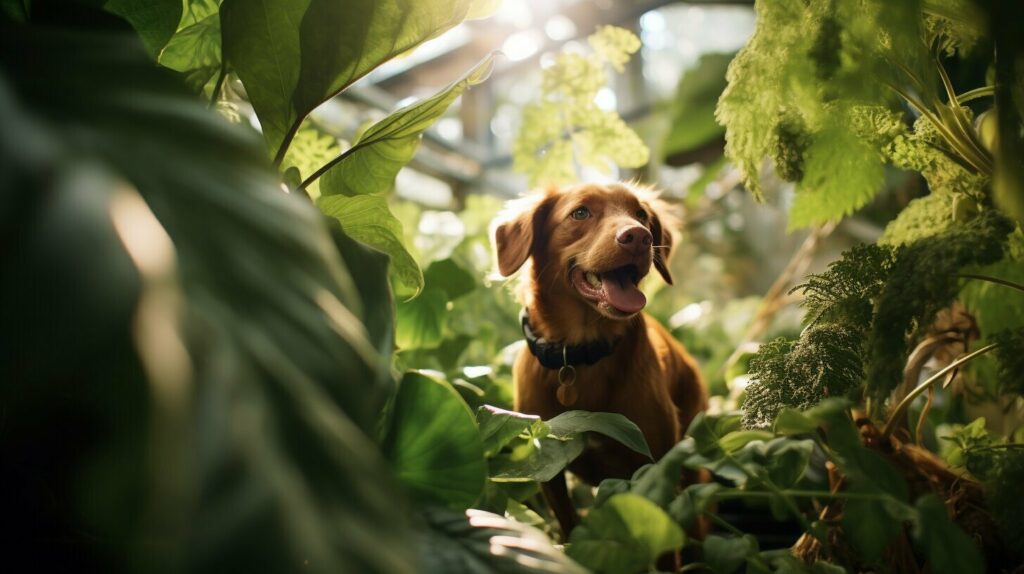
Additional Tips for Choosing Non-Toxic Plants
- Consider your living space: Take into account the lighting conditions in your home. Some plants require bright indirect light, while others can tolerate lower levels of light. Choose plants that will thrive in the available light in your living space.
- Think about maintenance: Different plants have varying water and care requirements. If you have a busy lifestyle or tend to forget about watering your plants frequently, opt for low-maintenance options that can tolerate dry conditions.
- Explore a variety of plant types: From palms to succulents, there is a wide range of dog-friendly houseplants available. Explore different types of plants to find those that not only suit your dog’s safety needs but also match your aesthetic preferences.
Sweetheart Plant (Hoya Kerrii)
When it comes to dog-friendly succulents, the Sweetheart Plant, also known as Hoya Kerrii, is a delightful choice. This charming plant features heart-shaped leaves, making it a favorite among pet owners. Not only is the Sweetheart Plant visually appealing, but it is also non-toxic to dogs, ensuring your furry friend’s safety.
The Sweetheart Plant is a relatively low-maintenance succulent that thrives in bright sunlight. It requires minimal watering, making it an ideal choice for busy dog owners. Its compact size makes it perfect for small spaces, such as apartments or offices, adding a touch of greenery without overwhelming the area.
Key Features of the Sweetheart Plant:
- Heart-shaped leaves
- Non-toxic to dogs
- Low-maintenance
- Tolerates bright sunlight
- Minimal watering
- Compact size

Areca Palm (Dypsis lutescens)
The Areca palm, also known as Dypsis lutescens, is an excellent choice for dog owners looking to add a touch of tropical beauty to their indoor space. Not only is this palm visually appealing with its graceful fronds, but it is also non-toxic to dogs, making it a safe and dog-friendly choice. Dogs are curious by nature, and having a plant like the Areca palm ensures that they can explore their surroundings without the risk of ingesting harmful substances.
The Areca palm is relatively low-maintenance and can thrive with the right care. It prefers bright indirect light, so placing it near a window where it can receive filtered sunlight is ideal. It’s important to avoid placing the plant in direct sunlight, as this can burn its leaves. As for watering, the Areca palm likes to keep its soil slightly moist during the spring and summer months, but it’s important not to overwater, as this can lead to root rot. It’s recommended to allow the top inch of soil to dry out before watering again.
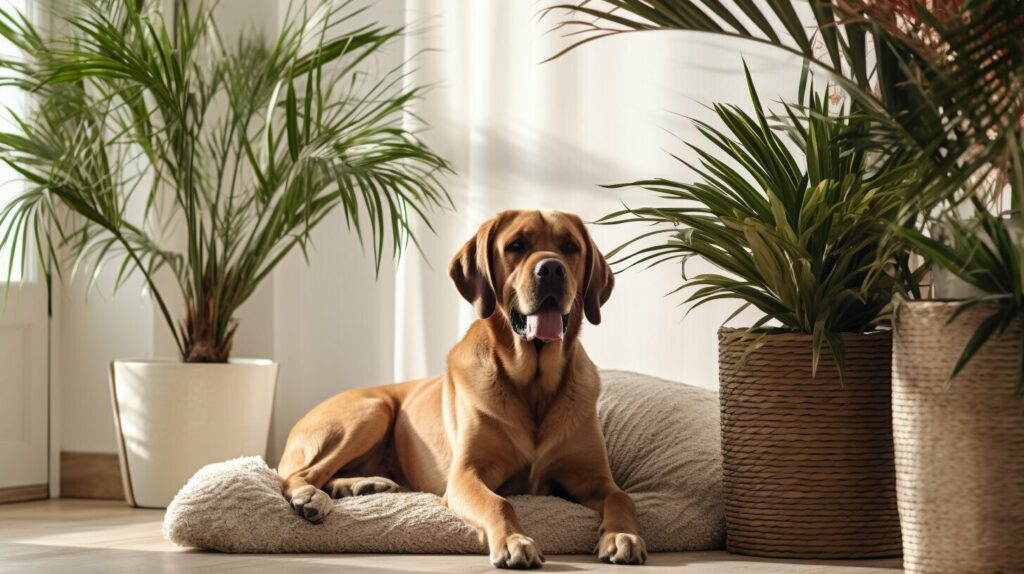
Benefits of the Areca Palm
- The Areca palm not only adds beauty to your indoor space but also helps improve air quality by removing toxins and releasing oxygen.
- It can act as a natural humidifier, increasing the moisture levels in dry indoor environments.
- The Areca palm has been found to have a calming effect, making it a great addition to spaces where you and your dog relax.
- It is a visually appealing plant that adds a touch of tropical elegance to any room.
With its dog-friendly nature and numerous benefits, the Areca palm is a popular choice among dog owners looking to create a green and pet-safe environment. Just remember to place the plant out of your dog’s reach to prevent any accidental nibbling on the leaves. As always, it’s important to keep an eye on your dog’s behavior around plants and consult your veterinarian if you suspect any health concerns.
Parlor Palm: A Pet-Safe Addition to Your Indoor Space
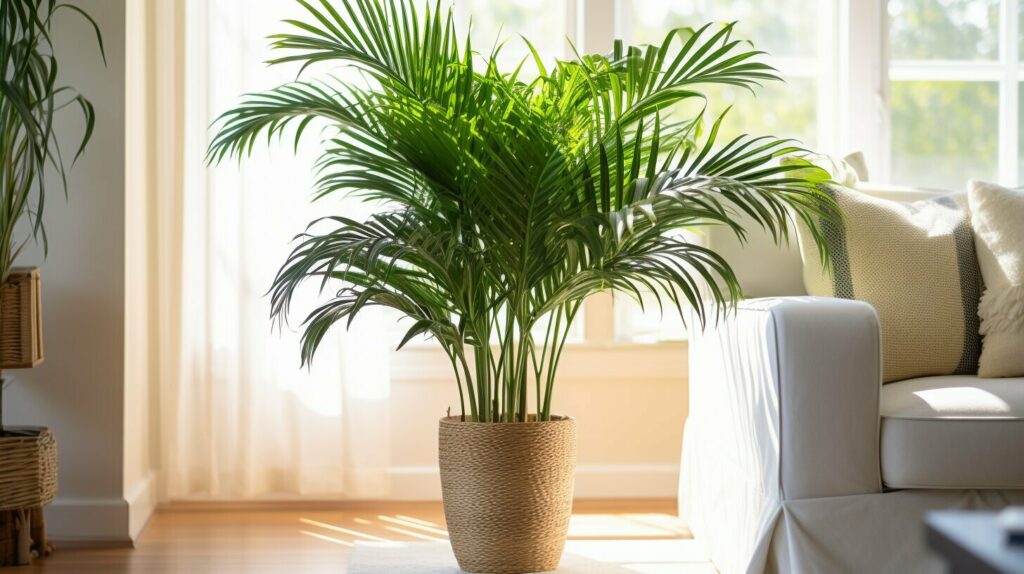
If you’re looking to add a touch of greenery to your home while ensuring the safety of your furry friend, the Parlor Palm is an excellent choice. Scientifically known as Chamaedorea elegans, this beautiful palm variety is not only visually appealing but also pet-safe. With its lush green fronds and compact size, the Parlor Palm can be a delightful addition to any indoor space.
The Parlor Palm thrives in bright indirect light, making it ideal for living rooms, offices, or bedrooms with ample natural light. It’s important to place the plant away from direct sunlight to prevent leaf burn. Additionally, ensure that the soil remains moist but not soggy by watering the plant when the top inch of soil feels dry. Proper care and maintenance will help your Parlor Palm flourish for years to come.
Benefits of Having a Parlor Palm:
- The Parlor Palm is non-toxic to dogs, ensuring your pet’s safety if they decide to take a nibble.
- It helps improve indoor air quality by filtering out harmful toxins and releasing oxygen.
- The dense foliage of the Parlor Palm adds a touch of elegance and tranquility to your space.
- Its compact size makes it suitable for small apartments or spaces with limited floor area.
- The Parlor Palm is relatively low-maintenance, making it suitable for both novice and experienced plant owners.
With its pet-safe nature and numerous benefits, the Parlor Palm is an excellent choice for dog owners looking to enhance their indoor environment with a touch of nature. Whether you place it on a tabletop or as a floor plant, the Parlor Palm is sure to bring beauty and a sense of calm to your home.
Cast-Iron Plant (Aspidistra elatior)
The cast-iron plant, scientifically known as Aspidistra elatior, is a perfect choice for pet owners looking for a low-maintenance and dog-friendly plant. This hardy houseplant earned its nickname due to its ability to withstand a variety of conditions, including low light, low humidity, and neglect. If you’re a busy dog owner or someone who doesn’t have a green thumb, the cast-iron plant is an excellent option for adding greenery to your home.
One of the standout features of the cast-iron plant is its lush, dark green foliage. The broad leaves are tough and leathery, making them resistant to damage from accidental paw swipes or curious nibbles. This plant is perfectly safe for dogs and won’t cause any harm if ingested. However, it’s always a good idea to discourage your furry friend from munching on any plants.
Benefits of the Cast-Iron Plant for Dogs:
- Non-toxic: The cast-iron plant is safe for dogs and won’t pose any harm if they decide to take a nibble.
- Low-maintenance: This plant is incredibly resilient and can adapt to various light and humidity conditions, making it perfect for busy dog owners or those new to plant care.
- Air-purifying: Like many houseplants, the cast-iron plant helps improve indoor air quality by naturally filtering out toxins.
- Greenery without fuss: With its attractive foliage and minimal care requirements, the cast-iron plant is an excellent choice for adding a touch of green to your home without the hassle.
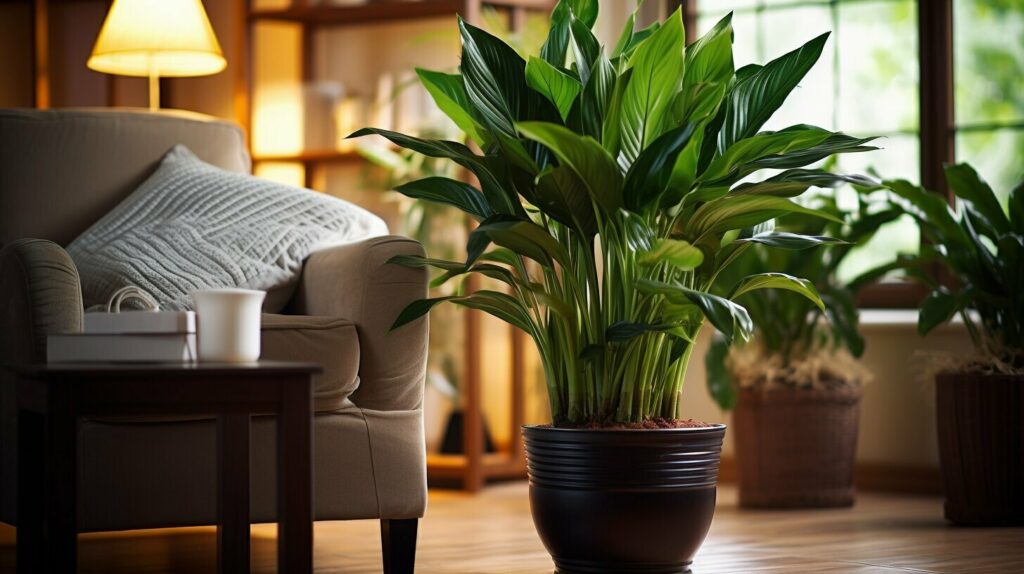
The cast-iron plant, with its hardy nature and dog-friendly qualities, is a fantastic addition to any dog-loving household. Its resilience and low-maintenance needs make it a stress-free plant to care for, ensuring that both you and your furry friend can enjoy its beauty without any worries.
Bromeliad (Bromeliaceae genera)
When it comes to dog-friendly tropical plants, bromeliads are a fantastic choice. These vibrant and colorful plants can brighten up any indoor space while ensuring the safety of your furry friend. Bromeliads belong to the Bromeliaceae family and come in various species, each with its unique characteristics.
Bromeliads are non-toxic to dogs, making them an excellent addition to your pet-friendly home. These plants require bright indirect light to thrive, so placing them near a window that provides filtered sunlight is ideal. They also prefer well-draining potting soil and should be watered when the soil is dry to the touch.
One notable feature of bromeliads is their ability to grow long-lasting and vibrant flowers. While it may take a few years for a bromeliad to bloom, the wait is well worth it. The striking and exotic blooms add a touch of elegance to your indoor space, making them a favorite among plant enthusiasts.

Growing Bromeliads: Tips and Care
- Provide bright indirect light: Bromeliads thrive in well-lit areas, but direct sunlight can scorch their leaves.
- Water properly: Avoid overwatering bromeliads. Allow the soil to dry out slightly between waterings to prevent root rot.
- Maintain humidity: Bromeliads appreciate a humid environment, so misting the leaves or placing them near a tray filled with water can help create the right conditions.
- Feed occasionally: Bromeliads are relatively low-maintenance plants, but you can give them a boost by applying a diluted fertilizer once every few months.
- Watch for pups: Bromeliads produce small offshoots known as “pups.” When the pups reach a reasonable size, they can be carefully separated and potted to grow into new plants.
Money Tree (Pachira aquatica)
When it comes to dog-friendly indoor trees, the Money Tree (Pachira aquatica) is a fantastic choice. Not only does it add a touch of elegance to any space, but it is also safe for dogs to be around. The Money Tree is known for its braided trunks and lush green leaves, which symbolize wealth and good fortune.
This beautiful tropical plant thrives in bright indirect light, making it perfect for placement near a sunny window. It prefers well-draining soil and should be watered when the soil is 50-75% dry. Avoid overwatering or allowing the plant to sit in standing water, as this can lead to root rot.
With its unique appearance and dog-friendly nature, the Money Tree is an excellent choice for pet owners looking to incorporate an indoor tree into their home. It not only adds natural beauty but also brings positive energy and good luck. So go ahead and bring home a Money Tree to enhance your living space while keeping your furry friend safe.
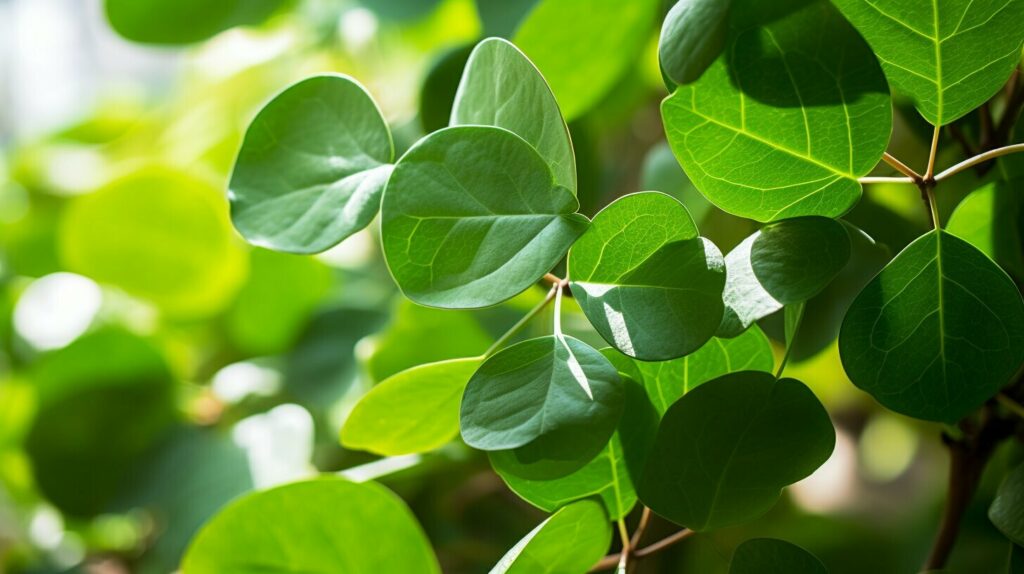
Benefits of Money Tree:
- Adds a touch of elegance and natural beauty to any space
- Safe for dogs, providing peace of mind for pet owners
- Symbolizes wealth and good fortune
- Thrives in bright indirect light
- Requires well-draining soil and moderate watering
- Brings positive energy and luck to your home
Baby Rubber Plant (Peperomia obtusifolia)
If you’re looking for a pet-friendly indoor plant that is both safe for dogs and visually appealing, the Baby Rubber Plant, scientifically known as Peperomia obtusifolia, is an excellent choice. This charming plant features glossy, thick leaves that add a touch of greenery to your home.
The Baby Rubber Plant is relatively low-maintenance, making it ideal for busy dog owners or those new to plant care. It thrives in medium to bright indirect light and can adapt to lower light conditions. This adaptability makes it suitable for different areas of your home, including offices, living rooms, or bedrooms.
Watering the Baby Rubber Plant is straightforward. Simply wait until the top inch of soil feels dry to the touch before thoroughly watering the plant. Avoid overwatering, as this can lead to root rot. Remember to always use a well-draining potting mix to prevent waterlogged soil.
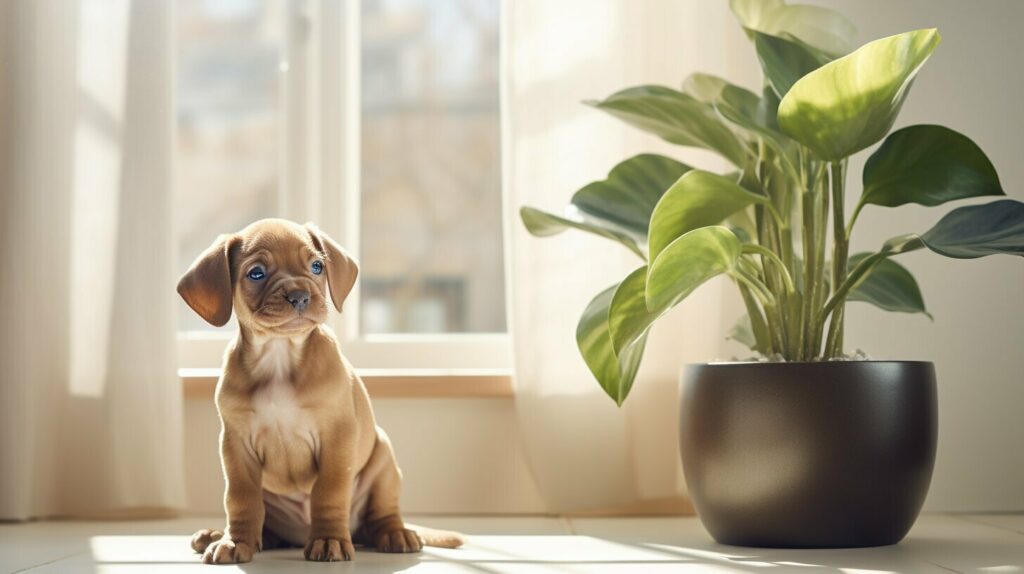
African Violet (Saintpaulia): Beautiful and Safe Flowering Plants for Your Home
When it comes to adding a pop of color to your home while ensuring the safety of your furry friend, African Violets, scientifically known as Saintpaulia, are an excellent choice. These flowering plants are not only visually appealing but also non-toxic to dogs, making them a perfect addition to your indoor plant collection.
African Violets thrive in indirect light, making them suitable for various areas of your home. Their vibrant petals come in a range of colors, including purple, pink, and white, allowing you to choose a hue that matches your decor. These delicate plants prefer a humid environment and should be watered when the soil is about 25% dry, ensuring they receive the right amount of hydration.
The Benefits of African Violets:
- Non-toxic: African Violets are safe for dogs, so you can enjoy their beauty without worrying about your furry friend’s well-being.
- Colorful Blooms: The vibrant flowers of African Violets can brighten up any room and add a touch of elegance to your space.
- Indoor Adaptability: These plants thrive indoors and can be grown in containers or hanging baskets, allowing you to create versatile displays.
- Easy Care: African Violets are relatively low-maintenance and forgiving if you occasionally forget to water them.
Whether you place them on your windowsill, a coffee table, or a hanging basket, African Violets can bring joy and beauty to your home without posing any harm to your beloved dog. Their pet-safe nature, stunning flowers, and adaptability to indoor environments make them a wonderful addition to any plant lover’s collection.

Spider Plant (Chlorophytum comosum)
When it comes to pet-friendly plants that can add a touch of greenery to your home, the Spider Plant (Chlorophytum comosum) is a fantastic choice. Its long, arching leaves with white stripes make it a visually appealing addition to any space. But what makes it even better is that it is non-toxic to both cats and dogs, making it a safe option for pet owners.
The Spider Plant is known for its ability to purify the air by removing harmful toxins, such as formaldehyde and carbon monoxide. This makes it not only a beautiful decoration but also a health-conscious choice for your home. The plant is also relatively low maintenance, making it perfect for both experienced plant parents and beginners.
- Spider Plants thrive in bright, indirect light but can also tolerate some shade.
- They prefer well-draining soil and should be watered when the top inch of soil is dry.
- One unique feature of the Spider Plant is its ability to produce small plantlets on long stems, called “spiderettes.” These can be easily propagated and used to grow new plants.
If you have curious pets who tend to nibble on plants, you can hang the Spider Plant in a hanging basket to keep it out of their reach. This way, you can enjoy the beauty of this pet-friendly plant without worrying about your furry friends getting into any trouble.
Prayer Plant (Maranta leuconeura)
If you’re looking for a dog-friendly plant that adds a touch of color and unique leaf patterns to your indoor space, the Prayer Plant (Maranta leuconeura) is an excellent choice. This popular houseplant is not only safe for dogs but also showcases interesting leaf movements, especially at night. The Prayer Plant gets its name from the way its leaves fold together, resembling hands in prayer.
The Prayer Plant is known for its striking foliage, featuring vibrant green leaves with intricate patterns of red veins that create a mesmerizing effect. These unique leaf patterns give the plant its visual appeal, making it a standout addition to any room. Place the Prayer Plant in a well-lit area, away from direct sunlight and drafts, to help it thrive.
This pet-friendly plant requires regular watering to keep the soil consistently moist but not waterlogged. To maintain its health and vigor, it’s essential to mist the leaves occasionally to provide the Prayer Plant with the humidity it craves. With proper care, this beautiful plant will continue to display its captivating patterns and bring joy to both you and your furry companion.
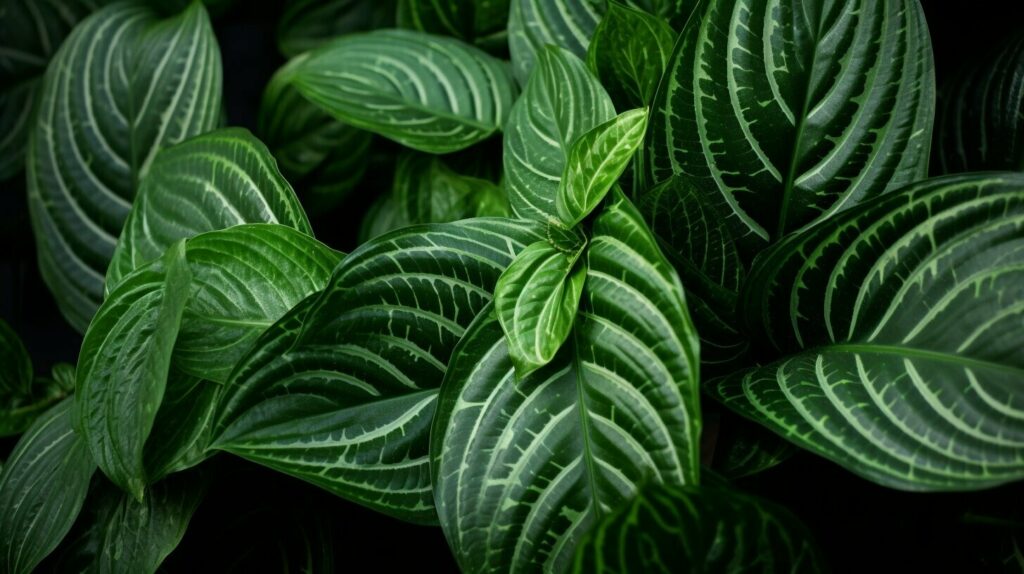
Benefits of the Prayer Plant:
- The Prayer Plant is safe for dogs, making it an ideal choice for pet owners.
- It features unique leaf patterns that add visual interest to your home.
- The plant’s leaf movements make it fascinating to observe, especially at night.
- It helps to purify the air, promoting a healthy and clean living environment.
Pony Tail Palm (Beaucarnea recurvata)
When it comes to finding a drought-tolerant indoor plant that is safe for your furry friend, the Pony Tail Palm is a fantastic choice. Also known as Beaucarnea recurvata, this unique plant features a thick bulbous trunk with long, slender leaves cascading from the top, resembling a ponytail.
The Pony Tail Palm is not only visually appealing but also low-maintenance, making it perfect for busy dog owners. It can tolerate periods of neglect and doesn’t require frequent watering. In fact, it thrives in well-drained soil and should only be watered when the soil has completely dried out.
This pet-safe plant prefers bright light, so placing it near a sunny window or under a grow light can ensure its growth and vitality. With its distinct appearance and ability to withstand dry conditions, the Pony Tail Palm is an excellent choice for adding a touch of nature to your home without compromising your dog’s safety.
Common Houseplants Toxic to Dogs
If you’re a dog owner and a plant lover, it’s important to know which houseplants can be toxic to your furry friends. While many houseplants can bring beauty and freshness to your home, there are several common varieties that can be harmful to dogs if ingested. To keep your four-legged companion safe, here are some houseplants you should avoid:
- Aloe Vera: Aloe vera is a popular houseplant known for its healing properties, but it can cause gastrointestinal upset and even tremors in dogs.
- Asparagus Fern: While it may look delicate and harmless, the asparagus fern can lead to vomiting, diarrhea, and abdominal pain in dogs if consumed.
- Devil’s Ivy: Also known as Pothos or Epipremnum aureum, devil’s ivy contains calcium oxalate crystals that can cause oral irritation, drooling, and difficulty swallowing in dogs.
- Dracaena: Dracaena plants, including varieties like the corn plant and dragon tree, can cause vomiting, loss of appetite, and even kidney damage in dogs.
- Peace Lily: Peace lilies are beautiful plants that can thrive in low-light environments, but they can cause irritation, difficulty swallowing, and increased salivation if consumed by dogs.
- Rubber Trees: Rubber trees, scientifically known as Ficus elastica, can cause vomiting, excessive drooling, and diarrhea in dogs due to the presence of toxic compounds.
- Snake Plants: Also called Sansevieria or mother-in-law’s tongue, snake plants contain saponins that can cause nausea, vomiting, and diarrhea in dogs.
It’s important to note that these are just a few examples, and there are other houseplants that can be toxic to dogs. If you suspect your dog has ingested a toxic plant or is exhibiting any symptoms of plant poisoning, it’s crucial to seek veterinary care immediately. Remember, prevention is key, so ensure that you keep these plants out of your dog’s reach to maintain a safe and dog-friendly environment in your home.
FAQ
Are these houseplants safe for dogs?
Yes, all the houseplants mentioned in this article are safe for dogs.
Why is it important to have dog-friendly indoor plants?
Dog-friendly indoor plants prevent dogs from ingesting toxic substances and help create a safe environment for them.
Which common houseplants should I avoid if I have a dog?
Avoid plants like aloe vera, asparagus fern, devil’s ivy, dracaena, peace lily, rubber trees, and snake plants, as they are toxic to dogs.
How can I find dog-friendly houseplants?
You can consult garden center staff, the Pet Poison Helpline, or ASPCA’s list of pet-safe plants. Cross-referencing information and consulting your veterinarian is also important.
Is the Sweetheart plant safe for dogs?
Yes, the Sweetheart plant, also known as Hoya Kerrii, is safe for dogs.
Can I keep an Areca palm around my dog?
Yes, Areca palms, also known as Dypsis lutescens, are safe for dogs.
Are Parlor palms safe to have around dogs?
Yes, Parlor palms, scientifically known as Chamaedorea elegans, are safe for dogs.
Are Cast-iron plants safe for dogs?
Yes, Cast-iron plants, also called Aspidistra elatior, are safe for dogs.
Can I grow bromeliads indoors if I have a dog?
Yes, bromeliads are safe to grow indoors around dogs.
What about Money Trees? Are they safe for dogs?
Yes, Money Trees, scientifically known as Pachira aquatica, are considered safe for dogs.
Can I keep a Baby Rubber plant around my dog?
Yes, Baby Rubber plants, also known as Peperomia obtusifolia, are safe for dogs.
Are African violets safe for dogs?
Yes, African violets, scientifically known as Saintpaulia, are safe for dogs.
Can I hang Spider plants around my dog?
Yes, Spider plants, also called Chlorophytum comosum, are safe for dogs and can be hung high to prevent dogs from reaching them.
Are Prayer plants safe for dogs?
Yes, Prayer plants, scientifically known as Maranta leuconeura, are safe for dogs.
Can I have a Ponytail palm if I have a dog?
Yes, Ponytail palms, also known as Beaucarnea recurvata, are safe indoor plants for dogs.

